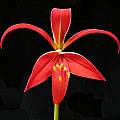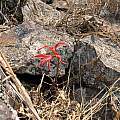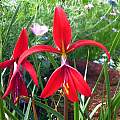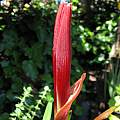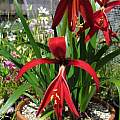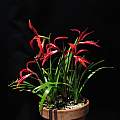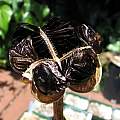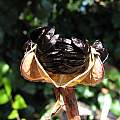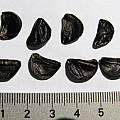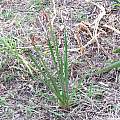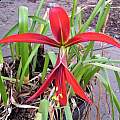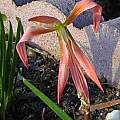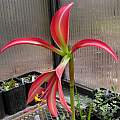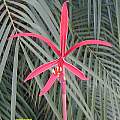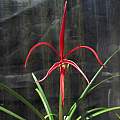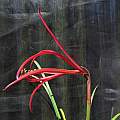Sprekelia is a small genus of only two species in the Amaryllidaceae family from Mexico, Central and South America. Sprekelia formosissima is the one most usually grown. The species are characterized by flamboyant red flowers with somewhat narrowed petals and long anthers and large stamens with yellow pollen.
×Hippeastrelia is our wiki page that shows pictures of hybrids between Hippeastrum and Sprekelia.
Sprekelia formosissima is native to Mexico. They do best in well-drained alkaline soil kept dry during their winter dormancy. However, Nhu Nguyen grows these bulbs in Northern California where they get winter rain without rotting. Perhaps the very sandy and well drained mix of little organic material and a terracotta pot helped. They may survive such a treatment but they don't bloom as prolifically with winter rain. Gianluca Corazza is also growing Sprekelia formosissima in a Mediterranean climate with success in Z9b in full soil (calcareous and well drained natural soil). He has no problem with winter rain but summer waterings are needed. His plants showed to be self-fertile. Height range: 15-30 cm. Wild populations have some variability, both in morphology and in physiology [CLINT, Plant Life (1962) 73-76].
They are prone to mealy bugs which hide in the crevices of the leaves. Keep an eye out for these insects as the leaves emerge. A little bit of fertilizer once or twice during the growing season keeps the plant happy. This species often requires genetic material from two different clones to set seeds. The mature stigma will be very sticky and readily accepts pollen. However, some rare population is self-fertile. Allow the seeds to mature and harvest when the pod breaks open, much like hippeastrums. Seeds can be sown directly into a well drained medium or using the floating method to germinate and carefully sown after germination. It takes 4-7 days for germination to occur using the floating method. It is recommended that the plants should be kept moist and growing for the first two years indoors without a winter dormancy. It takes about 7 years for a seed-grown plant to mature and flower.
This is a specimen that was collected in the central Mexican highlands at around 1750 m and is now growing in my garden. The color, shape and size are outstanding. The flower is as large as a hand with my fingers spread. The first rains here in Mexico, (roughly at the beginning of May) cause these flowers to emerge in the dry countryside. Photo taken in Mexico, April 23, 2005 by Dennis Szeszko.
Photo 1 was taken by Sheila Burrow, photos 2-6 were taken by Nhu Nguyen. Photo 1 shows the flower at the peak of its bloom. Photo 2 shows the bud. Photo 3 shows the plants and their habit. Photo 4 shows the stamens and a glistening pistil. Photos 5-6 shows a pot full of bulbs at peak blooming.
This photo series taken by Nhu Nguyen features seed development in this species. Photo 1 shows the maturing seed pod. Photos 2-3 show the mature seeds still on the plant. Photo 4 shows the seeds laid against a ruler.
The following photo shows ripening seed pods. This fruits were obtained by Gianluca Corazza after selfing each flower in a self-fertile clone. Germination was then very good.
Photo of the cultivar known as 'Orient Red'. Much more robust grower and easier blooming than the common species. Some years there are 6 or 7 flushes of blooms starting as early as January and going on until the late Fall. Photo taken March 2004 by Lee Poulsen.
After having "cleared" a bed of Sprekelia bulbs, this pink offset came up. I came near to digging it up and to the trash. I didn't, it bloomed, and here it is. What a surprise! Photo by Doug Westfall.
This is an unknown cultivar that seems to have lighter colored midribs than most. Appears to re-bloom easily. Photo taken in November, 2006 by Roy Herold.
Sprekelia howardii was discovered from Southern Mexico and described in 2000 by D. Lehmiller. It is a much smaller species than S. formosissima with much narrower petals and leaves. Treat this species the same way as S. formosissima although a dry dormancy is a must. Repotting must be done carefully as the plant may skip a year of blooming if the roots are disturbed too much. Doug Westfall reported that pollen from S. formosissima microwaved for 20 seconds, then mixed with fresh pollen of S. howardii can be used to pollinate the same plant of S. howardii. The reasoning is that microwaving the pollen will kill the sperm but still allow the self-incompatibility mechanism on the stigma to be turned off. Once it is turned off, the S. howardii pollen can pollinate itself. However, there is still a potential for the F1 to be hybrids using this technique. Height range: to about 15 cm. Photo 1 was taken by Doug Westfall who is growing this species in Southern California. Photos 2-3 were taken by Nhu Nguyen of plants grown in Berkeley, California.
